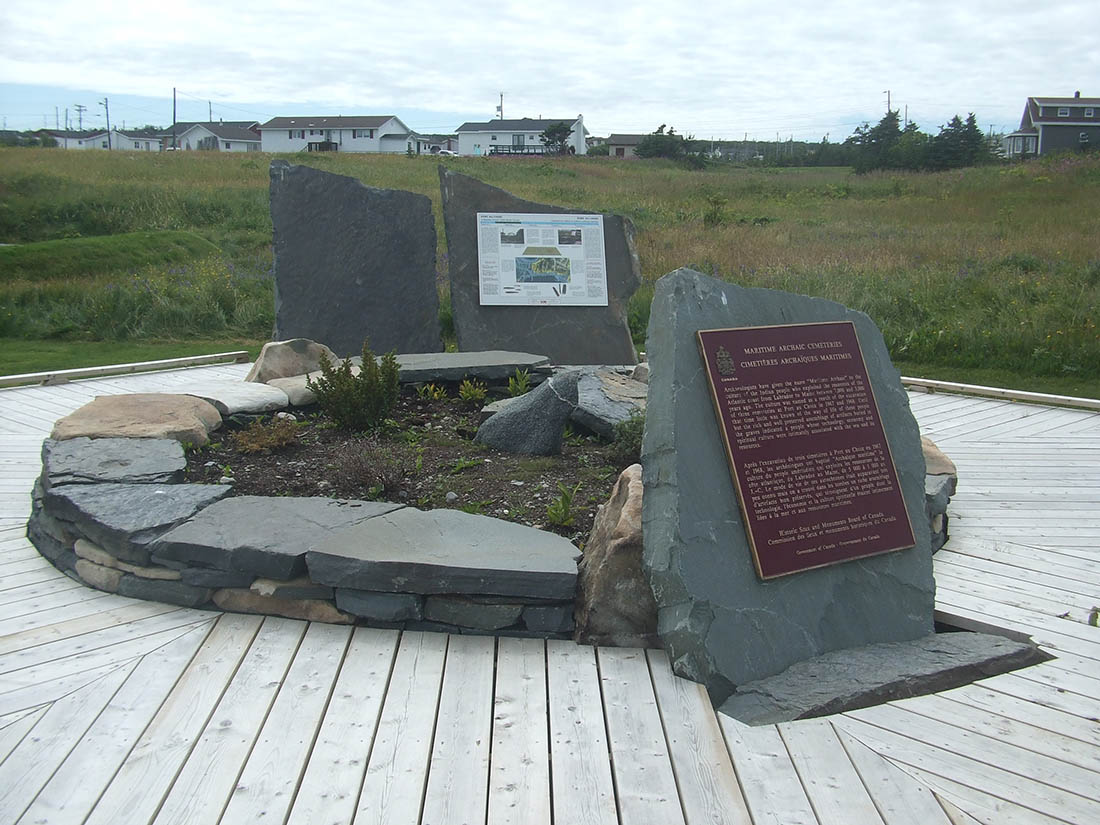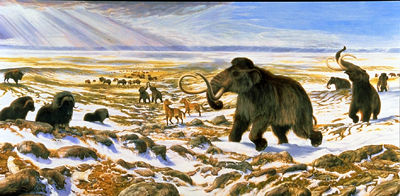According to Indigenous oral histories in Newfoundland and Labrador, Indigenous peoples have lived in this territory since time immemorial. According to archaeology, the history of early Indigenous peoples in Newfoundland and Labrador begins at least 9,000 years ago. Archaeological cultures are defined by archaeologists and do not necessarily align with how Indigenous peoples in the past and present identify themselves. Archaeologists organize early Indigenous peoples into three main groups based on common ancestry. They are the First Nations Archaeological Cultures, Paleo-Inuit Archaeological Cultures and Inuit Archaeological Cultures.
History of Early Indigenous Peoples in Canada
There are varying understandings about how early Indigenous peoples arrived in the Americas. Some Indigenous oral histories indicate that their peoples have been in the Americas since time immemorial. Past archaeologists and anthropologists commonly speculated on three main ways that people arrived in the Americas. These theories include the Bering Land Bridge (Clovis-First) Theory, the Coastal Migration Theory and the Solutrean Hypothesis.
Bering Land Bridge (Clovis-First) Theory
The Bering Land Bridge (Clovis-First) Theory proposes that early Indigenous peoples moved into North America through a land bridge connecting modern-day Siberia and Alaska about 14,000 years ago. Archaeologists believe early Indigenous peoples made their way into the central region of North America through an ice-free corridor between two massive sheets of ice. During this time, Newfoundland and Labrador was covered in a massive ice sheet called the Laurentide Ice Sheet. These peoples are commonly called the “Clovis,” as they shared a similar tool type. This is the most widely accepted theory on how early Indigenous peoples arrived in the Americas.

Coastal Migration Theory
The Coastal Migration Theory also speculates that early Indigenous peoples crossed from Siberia to Alaska. However, it argues early Indigenous peoples accessed the Americas using a coastal route along the Pacific coast of Alaska and British Columbia.
Solutrean Hypothesis
The Solutrean Hypothesis is the least accepted hypothesis for how early Indigenous peoples arrived in North America. It states that early Indigenous peoples entered the Americas from Europe via the Atlantic Ocean (by boat and ice). It argues a connection between early Indigenous peoples in the Americas and Solutrean peoples, who lived in what is now Portugal, Spain and southern France.
Each of these theories speculates that early Indigenous peoples arrived in the Americas around the same time, approximately 14,000 to 20,000 years ago. However, Dr. Paulette Steeves, a Cree-Métis archaeologist, believes that Indigenous peoples arrived in the Americas over 130,000 years ago. Her argument is based on Indigenous oral histories, archaeological evidence and a decolonized approach to archaeology. Regardless of how early Indigenous peoples arrived in the Americas, they are the ancestors of Indigenous peoples in Canada, including in Newfoundland and Labrador.
Early Indigenous Peoples in Newfoundland and Labrador
According to Indigenous oral histories, their ancestors have been living in what is now Newfoundland and Labrador since time immemorial. Archaeological evidence (e.g., past human belongings) dates back to about 9,000 years ago. Archaeologists call these early Indigenous peoples “Archaeological Cultures,” and group them into three main categories: First Nations Archaeological Cultures, Paleo-Inuit Archaeological Cultures, and Inuit Archaeological Cultures. Each of these cultures had their own tools, subsistence patterns and settlement structures. Archaeologists used these characteristics to classify them into groups.
First Nations Archaeological Cultures
First Nations Archaeological Cultures are thought to share common ancestry with contemporary First Nations. These were the first humans to call Newfoundland and Labrador home. They arrived in Labrador from what is now Quebec. They descended from early Indigenous peoples living there. This category includes Labrador Archaic and Maritime Archaic peoples, Intermediate (Early Boreal Woodland) Period peoples, and Recent (Late Boreal Woodland) Period peoples.
Labrador and Maritime Archaic Peoples
The Labrador and Maritime Archaic peoples were the first humans to arrive in Newfoundland and Labrador. They lived in the province from around 9,000 to 3,200 years ago. They are thought to be two related branches of one bigger group, commonly called the Maritime Archaic. The Labrador Archaic are known as the Northern Branch. They lived in northern Labrador from around 9,000 to 3,500 years ago. The Maritime Archaic are known as the Southern Branch, and they lived in southern Labrador, Newfoundland and the Maritimes from around 6,500 to 3,200 years ago. Their toolkit, which reflected their reliance on marine resources for survival, included chipped stone tools such as triangular projectile points, as well as watercraft, gouges and toggling harpoons. Labrador Archaic tools appear to be smaller than those of the Maritime Archaic who lived in the south. Archaeologists are not sure what happened to the Labrador and Maritime Archaic, as evidence of the continuation of their cultures disappeared from the archaeological record. Some believe they experienced competition with the Pre-Dorset, who moved into the area around 4,100 years ago.

Intermediate (Early Boreal Woodland) Period Peoples
Following the Labrador and Maritime Archaic were the Intermediate Period peoples. They lived in the territory from about 3,200 to 2,000 years ago. To date, there is no substantial presence of Intermediate Period peoples on the island of Newfoundland, with only a couple of archaeological sites recorded on the island. There are debates among archaeologists regarding how to divide this cultural group. Many believe there are two subcultures, the Saunders Complex and the North West River Phase. However, some archaeologists believe these peoples sustained themselves using seasonal rounds with reliance on land mammals. Their toolkit includes a variety of tools made from Saunders chert and white-brown quartzite. These tools include sharp, one-sided or wide blades, small scrapers shaped like thumbnails, long and narrow stone blades, projectile points, flake tools, stemmed scrapers and scrapers made from stone cores. Red ochre was also a notable part of their toolkit.
Recent (Late Boreal Woodland) Period Peoples
The Recent Period peoples lived in Newfoundland and Labrador from about 2,000 to 400 years ago. Archaeologists put various groups into the Recent Period peoples Archaeological Cultures, including the Little Passage, Beaches, Daniel Rattle, Point Revenge and Cow Head Complexes. Their toolkit included bows and arrows, which they used to hunt caribou and small mammals in seasonal rounds.
Contemporary First Nations
Following the Recent Period peoples, the archaeological and anthropological record shows contemporary First Nations, including the Mi’kmaq, Innu and Beothuk. Some believe that the Innu and Beothuk descended from the Recent Period peoples. However, this assertion is debated amongst archaeologists. Work is needed to determine the origin of these sites as archaeological processes advance.
Paleo-Inuit Archaeological Cultures
The Paleo-Inuit Archaeological Cultures are thought to be the first people to live in the Arctic —likely sharing a common ancestor and tool technology. This tool technology is commonly referred to as the Arctic Small Tool Tradition, and it includes the Pre-Dorset, Groswater and Dorset subcultures.
Pre-Dorset
During the same time as the Labrador Archaic and Maritime Archaic, the Pre-Dorset lived in northern Labrador. They lived there from around 4,100 to 3,500 years ago. The Pre-Dorset are believed to have descended from the Denbigh Flint Complex in Alaska. Archaeological evidence from Saglek Bay and the Nain region suggests they shared the Labrador coast with the Maritime Archaic, though it’s unclear if they interacted. The Pre-Dorset used tools like bows and arrows, triangular end blades and harpoon heads to hunt land and sea mammals as part of their seasonal way of life. They may have moved north or disappeared due to climate change.
Groswater
The Groswater lived throughout the territory from around 2,800 to 1,900 years ago. They were once thought to have simply succeeded the Dorset culture, rather than changed into it. However, archaeologists have differing views. Some see the Groswater as a distinct group. Others suggest they may have been a transitional population between the Pre-Dorset and Dorset or were a regional variation of the Pre-Dorset, called the Groswater Pre-Dorset. The Groswater used fluted stone blades, ground tools and harpoon heads. They relied on both land and marine resources. They lived in Labrador, Newfoundland and Quebec’s Lower North Shore, often reusing earlier Maritime Archaic sites.
Dorset
The Dorset lived in the territory from about 2,500 to 700 years ago. They typically used blades with fluted tips, tools shaped like chisels, blades with several notches, rectangular bowls made of soapstone, harpoon tips, sleds, and partially underground houses. They lived in more intensive, larger communities than the Pre-Dorset. Archaeologists think they hunted large marine mammals (including seals), as indicated by remains found at the Port au Choix site in Newfoundland. Also, archaeologists think that the Dorset and the early Inuit could have interacted, with the Dorset referred to as Tuniit in Inuit oral history.

Contemporary Paleo-Inuit
Archaeologists believe these cultural groups to be culturally extinct. It is believed, though, that the Paleo-Inuit and Inuit share a common ancestor far back in time in Siberia.
Inuit Archaeological Cultures
Inuit Archaeological Cultures include two related groups, the early Inuit (formerly called “Thule”) and the Inuit. The early Inuit, living in Labrador from approximately 700 years ago to contact with Europeans, are the ancestors of Inuit living in Labrador today. The early Inuit toolkit included items like ulus, soapstone lamps (kulik), sleds (kamituk), sealskin floats, tents (tupiq), kayaks, large boats (umiat), bow drills and wood snow goggles. They also adopted European goods such as iron, brass, ceramics and gunflint. Early on, whaling was common. Later, hunting shifted to smaller animals along with fishing and harvesting other marine resources. Land resources played a smaller role. The early Inuit period ended about 400 years ago, transitioning into the contemporary Inuit of Labrador.
Conclusion
The deep history of the Americas is now being reconsidered through the groundbreaking work of Cree-Métis archaeologist Paulette Steeves. In Newfoundland and Labrador, archaeological evidence of 9,000 years of habitation reveals a rich cultural history encompassing three main groups and their subcultures. Each group developed unique tools and subsistence practices, while coastal and inland groups shared notable similarities. However, some archaeologists argue that it is crucial to incorporate Indigenous oral histories to fully understand this deep history. Indigenous oral histories can provide vital connections between the archaeological record and Indigenous histories, offering a more inclusive and holistic narrative of the past.

 Share on Facebook
Share on Facebook Share on X
Share on X Share by Email
Share by Email Share on Google Classroom
Share on Google Classroom






